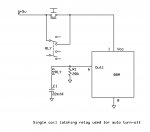Grant Fleming
Senior Member
I am looking to obtain a few relays. I have searched the forums and found the '40c latching relays' that were offered on Ebay previously.
Has anyone been using a latching relay for their PICAXE projects that is readily available & can be driven directly off the pin? A coil using less than 20mA, contacts to switch up to 250Vac with 250mA.
Having searched on-line catalogues of many of the larger suppliers I find many, but the ones with the least coil current are still 30mA.
Cheers
Grant
Has anyone been using a latching relay for their PICAXE projects that is readily available & can be driven directly off the pin? A coil using less than 20mA, contacts to switch up to 250Vac with 250mA.
Having searched on-line catalogues of many of the larger suppliers I find many, but the ones with the least coil current are still 30mA.
Cheers
Grant

